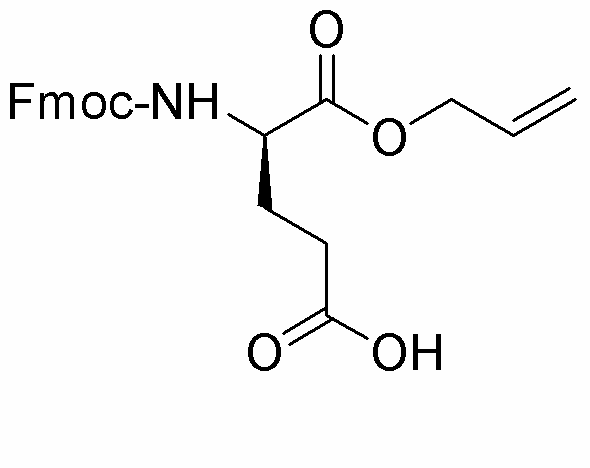Fmoc-D-glutamic acid a-allyl ester is widely utilized in research focused on:
- Peptide Synthesis: This compound serves as a key building block in the synthesis of peptides, particularly in solid-phase peptide synthesis, allowing for the creation of complex peptide structures.
- Drug Development: Its unique properties make it valuable in the pharmaceutical industry for developing new drugs, especially those targeting neurological disorders, due to its ability to mimic natural amino acids.
- Bioconjugation: The allyl ester group enables selective reactions for bioconjugation, facilitating the attachment of biomolecules to surfaces or other molecules, which is crucial in creating targeted therapies.
- Research in Neuroscience: It is used in studies related to neurotransmitter functions and signaling pathways, providing insights into brain function and potential treatments for cognitive disorders.
- Material Science: The compound can be incorporated into polymer matrices to enhance material properties, making it useful in developing advanced materials for various applications.
General Information
Properties
Safety and Regulations
Applications
Fmoc-D-glutamic acid a-allyl ester is widely utilized in research focused on:
- Peptide Synthesis: This compound serves as a key building block in the synthesis of peptides, particularly in solid-phase peptide synthesis, allowing for the creation of complex peptide structures.
- Drug Development: Its unique properties make it valuable in the pharmaceutical industry for developing new drugs, especially those targeting neurological disorders, due to its ability to mimic natural amino acids.
- Bioconjugation: The allyl ester group enables selective reactions for bioconjugation, facilitating the attachment of biomolecules to surfaces or other molecules, which is crucial in creating targeted therapies.
- Research in Neuroscience: It is used in studies related to neurotransmitter functions and signaling pathways, providing insights into brain function and potential treatments for cognitive disorders.
- Material Science: The compound can be incorporated into polymer matrices to enhance material properties, making it useful in developing advanced materials for various applications.
Documents
Safety Data Sheets (SDS)
The SDS provides comprehensive safety information on handling, storage, and disposal of the product.
Product Specification (PS)
The PS provides a comprehensive breakdown of the product’s properties, including chemical composition, physical state, purity, and storage requirements. It also details acceptable quality ranges and the product's intended applications.
Certificates of Analysis (COA)
Search for Certificates of Analysis (COA) by entering the products Lot Number. Lot and Batch Numbers can be found on a product’s label following the words ‘Lot’ or ‘Batch’.
Numéro de catalogue
Numéro de lot/série
Certificates Of Origin (COO)
This COO confirms the country where the product was manufactured, and also details the materials and components used in it and whether it is derived from natural, synthetic, or other specific sources. This certificate may be required for customs, trade, and regulatory compliance.
Numéro de catalogue
Numéro de lot/série
Safety Data Sheets (SDS)
The SDS provides comprehensive safety information on handling, storage, and disposal of the product.
DownloadProduct Specification (PS)
The PS provides a comprehensive breakdown of the product’s properties, including chemical composition, physical state, purity, and storage requirements. It also details acceptable quality ranges and the product's intended applications.
DownloadCertificates of Analysis (COA)
Search for Certificates of Analysis (COA) by entering the products Lot Number. Lot and Batch Numbers can be found on a product’s label following the words ‘Lot’ or ‘Batch’.
Numéro de catalogue
Numéro de lot/série
Certificates Of Origin (COO)
This COO confirms the country where the product was manufactured, and also details the materials and components used in it and whether it is derived from natural, synthetic, or other specific sources. This certificate may be required for customs, trade, and regulatory compliance.


